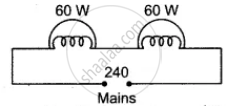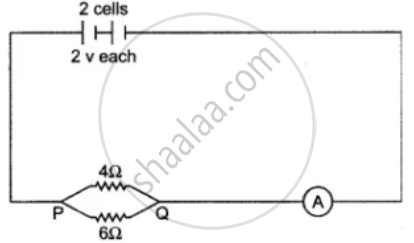Advertisements
Advertisements
प्रश्न
An electric bulb is rated 240V-60W and is working at 100% efficiency.
(i) Calculate the resistance of bulb.
(ii) (a) Draw the circuit diagram.
(b) What is the rate of conversion of energy in each bulb?
(c) Total power used by the bulbs.
उत्तर
(i) From P = `"V"^2/"R"`
Resistance of bulb (R) = `"V"^2/"P" = (240 xx 240)/60 = 960 Omega`
(ii) (a)

(b) Resistance of bulbs in series = (960 + 960) Ω = 1920 Ω
∴ Current in series circuit I = `"V"/"R" = 240/1920 = 0.125` A
∴ Rate of conversion of energy in any one bulb in 1 second = I2Rt
= (0.125)2 × 960 × 1 = 15.5
(c) Power of 1 bulb in series circuit = 15 W
So poewr of 2 bulb in series circuit = 2 × 15 W = 30 W.
APPEARS IN
संबंधित प्रश्न
Which of the following terms does not represent electrical power in a circuit?
An electric motor takes 5 amperes current form a 220 volt supply line. Calculate the power of the motor and electric energy consumed by it in 2 hours.
Define kilowatt-hour.
Point out two main disadvantages of ‘Tree System’.
Which material is the calorimeter commonly made of? Give one reason for using this material.
Name a metal that is used as an electron emitter. Give one reason for using this metal.
What is ‘Rating’ of an electric appliance?
At what voltage is the electric power generated at the generating station? Explain the transmission of this power to your house.
With reference to the diagram shown below calculate:

(i) The equivalent resistance between P and Q.
(ii) The reading of ammeter.
(iii) The electrical power between P and Q.
Two resistances R1 = 4Ω and R2 = 6Ω are connected in series. The combination is connected with a battery of e.m.f. 6V and negligible resistance. Calculate:
(i) the heat produced per minute in each resistor,
(ii) the power supplied by the battery.
